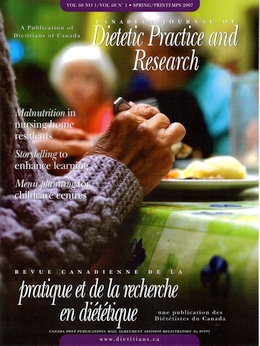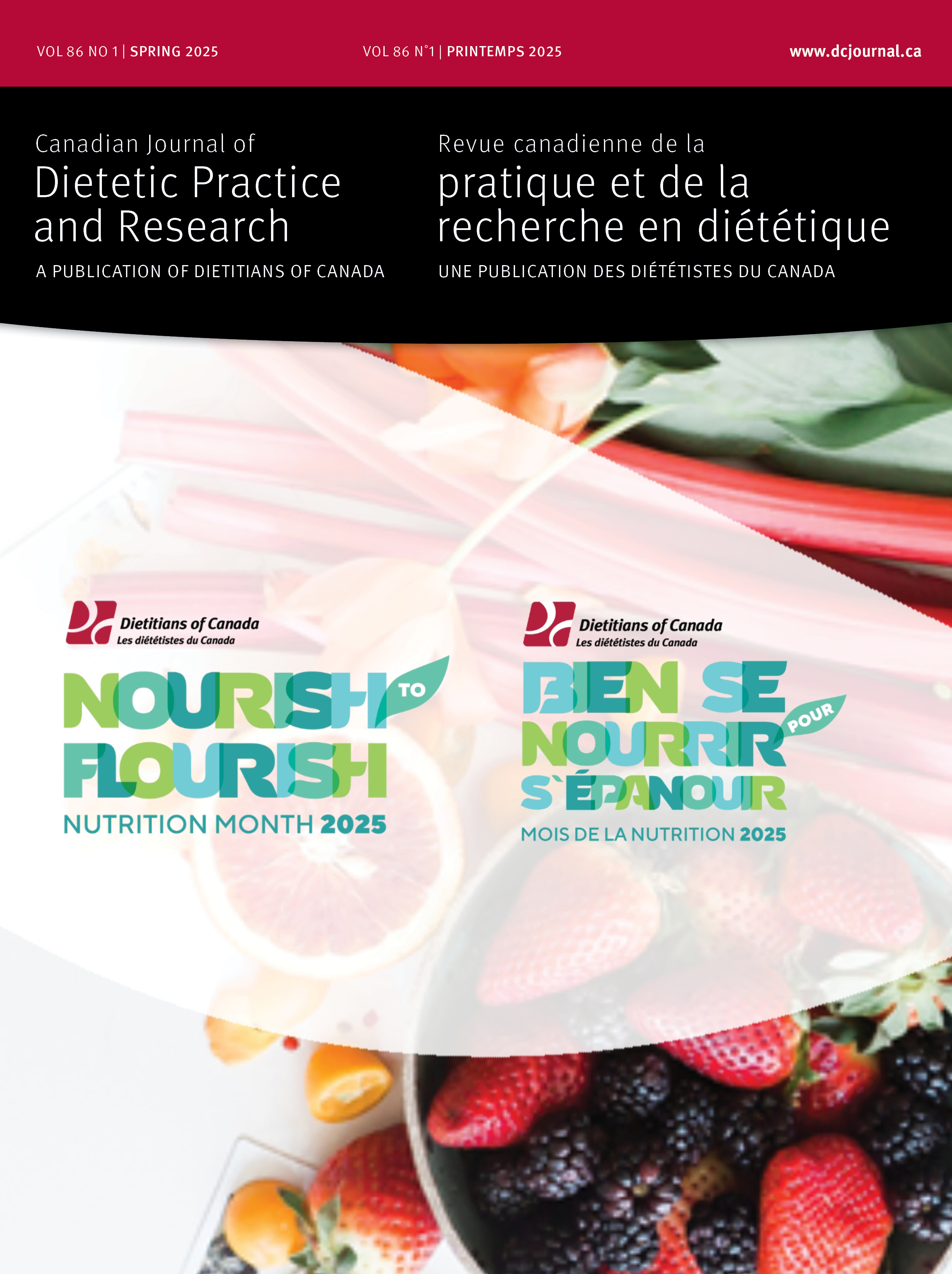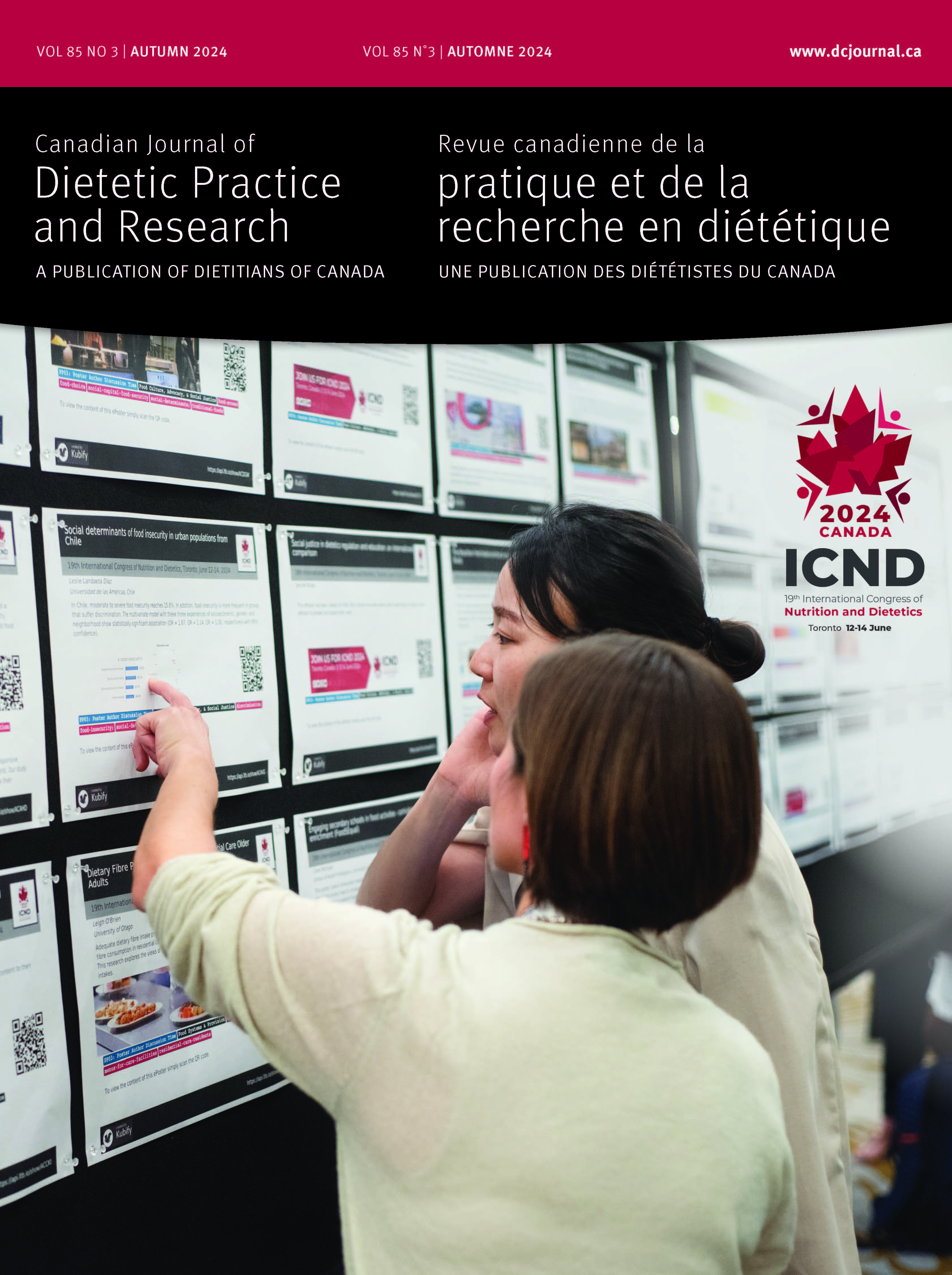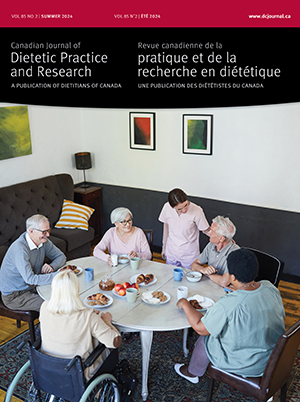Volume 68 • Number 1 • March 2007
Chair’s Message
Editor’s Message
Research
Purpose: Childcare menu planners’ relevant knowledge, attitudes, and practices were determined, as were the menu planning guidelines or tools needed and the nutritional adequacy and quality of menus in licensed full-day childcare centres in Nova Scotia. Methods: An ethics committee-approved questionnaire was mailed to a stratified random sample of 101 licensed childcare centres across the province. Respondents were instructed to forward a copy of their current four-week menu for nutrient analysis and menu quality evaluation. Results: Descriptive statistical data analysis from the returned questionnaires (n=35) indicated that fewer than 50% of the menu planners had relevant training and knowledge. Discrepancies exist between attitudes about good menu planning and practices. A positive finding was that most respondents used reliable resources for menu planning and expressed a desire for updated resources and ongoing training in child nutrition/ menu planning. A number of nutrient and menu quality deficiencies were identified from the menus submitted (n=28). A significant statistical correlation was found between menu planning training and higher menu quality scores. Conclusions: The results will be relevant to nutritionists in the development of effective resources and training for childcare centre menu planners.
Purpose: Links between food service characteristics and residents’ risk of malnutrition were examined. Methods: Cognitively intact residents meeting inclusion criteria and living in one of 38 participating nursing homes were randomly sampled. The final sample consisted of 132 residents, who were screened for risk of malnutrition and completed a face-to-face interview questionnaire about dining experiences. Additional data came from participants’ medical charts, and each institution's food service manager completed a written questionnaire. Frequencies and logistic regressions were used to describe the sample and to examine relationships between risk of malnutrition and food service characteristics. Results: Overall, 37.4% of participants were at risk of malnutrition. Food service factors, including food packages, lids, and dishes that were difficult to manipulate (β=0.285, p=0.009), bulk food-delivery systems (β=1.329, p=0.036), overall food satisfaction (β=0.253, p=0.044), menu cycle length (β=-2.162, p=0.003), and porcelain dishes (β=-0.345, p=0.052), all were significantly associated with risk of malnutrition. Conclusions: Our findings clearly show a need for nursing homes to modify certain aspects of food service that may increase the risk of malnutrition among cognitively intact residents.
Purpose: The prevalence of micronutrient inadequacies was assessed among adult residents of Prince Edward Island (PEI) in the PEI Nutrition Survey. Methods: A peer-reviewed protocol was used in this crosssectional survey, in which 24-hour recalls were administered during in-home interviews. A stratified random sample of 1,995 adults aged 18 to 74 participated. Median nutrient intakes with and without supplements were calculated; intakes were adjusted for day-to-day variability. Chi-square testing was used to assess differences in prevalence of inadequacy by age and sex. Results: Most of the sample (more than 90%) had folate intakes below the Estimated Average Requirement (EAR). Magnesium and vitamin C intakes were low in more than 50% of the sample. Iron intakes were adequate in all groups except women aged 19 to 50, 29% of whom had intakes below the EAR. Women were more likely than men to have inadequate intakes. Median calcium intakes fell below recommendations for all age and sex groups. Supplement use had little impact on dietary adequacy in this sample. Conclusions: This study underscores the need for public health interventions designed to reduce the very high prevalence of nutrient inadequacies in the PEI adult population. In addition, education is needed on the selection of appropriate vitamin and mineral supplements.
Purpose: The impact of storytelling in the classroom was examined, as was what motivates individuals to engage in storytelling. Methods: A storytelling methodology was introduced in an undergraduate nutrition course as an opportunity to enhance the teaching and learning environment. A 28-item, multi-part, self-administered survey was then distributed to the class (n=17). Results: Survey responses (n=15, 88% response) indicate that educators’ and students’ storytelling can positively influence the learning environment. This occurs through the creation of a greater focus on personalized information, glimpses of real-life experience, a connection with a topic as participants recognize similarities in their own personal experience and knowledge, and connections between different topics and through the emphasis on key concepts. Stories initiate useful conversations about unexplored struggles within practice, such as the emotional dimension(s) of an issue or what it means to be professional. Students are motivated to participate in storytelling through an external focus on others (i.e., helping others to learn) and an internal focus on self (i.e., seeking a connection with others to promote social dialogue). Several challenges related to the use of storytelling in the classroom emerged. Conclusions: Storytelling develops ways of knowing and dialoguing about issues, which has the potential to influence how students will approach their professional practice.
Perspectives in Practice
Purpose: Dietetic internships provide practical experience leading, in most cases, to the attainment of entry-level dietetic competence. Problematic intern performance issues were examined, as were how educators resolve these issues and the supports they require to manage them. Methods: A survey was electronically distributed to all Dietitians of Canada internship/university course directors (n=57). The response rate was 40% (n=23). Results: Annually, 61% of internships involve challenging performance issues related to intern knowledge, skills, attitude, and behaviour. These issues manifest themselves individually or in combination as an intern's inability to apply/demonstrate appropriate knowledge/skill, a view/approach to the profession that is not in keeping with the organizational view, an attitude that is in conflict with program values, a negative response to feedback, an inability to relate to others, work habits that are in conflict with program values, and personal attributes that detract from the ability to meet program expectations. Educators respond to these issues by modifying their communications, the learning environment, and the program. Conclusions: Educators’ strategies could be enhanced through consultation with other educators, mentor training, and the development of formal procedures.
Report
Purpose: The relationships are explored between food choices of school-aged children and eating in the bedroom, while watching television, or in front of the computer. Methods: Data were collected using a self-administered questionnaire that 534 subjects completed in class. Participants were ten- to 12-year-old children from Québec. Results: Significant positive correlations were found between the act of eating in the bedroom and eating in front of the television or the computer (p<0.05). Significant positive correlations were also found between eating in the bedroom, or eating in front of the television or the computer, and the consumption of low-density food, foods high in sugar and fat, and foods low in fibre (p<0.05). Data also revealed more negative food habits for boys than for girls (p<0.05). Conclusions: Because of the prevalence of childhood obesity, these findings support the need to document children's food consumption patterns and gender differences.
Purpose: The impact of consuming processed versus fresh fruits and vegetables on the galactose intake of galactosemic patients was compared. Methods: The galactose content of processed fruits was determined when the following processing methods were used: freezing, drying, blanching, microwaving, canning, and a combination of blanching and freezing. Then three-day food intakes of five subjects with galactosemia were recorded. The records were used to estimate galactose intake, according to previously reported galactose levels for fresh fruits and vegetables and the potential reduction in galactose intake when only processed fruits and vegetables are consumed. Results: The average galactose reduction was approximately 45% for all the fruits and all processing methods, excluding drying. Intakes varied from 17 to 108 mg/day when fresh values were used and 11 to 103 mg/day when only processed fruits and vegetables were consumed. This reduction was statistically significant for four out of five patients. Conclusions: When the reduction is compared with reported daily fluctuations in galactosemic patients’ endogenous galactose production, the clinical significance of reduced free galactose consumption on long-term outcome is unclear. However, metabolic dietitians now have objective data that the processing methods described will lower the free galactose content of the fruits analyzed.










